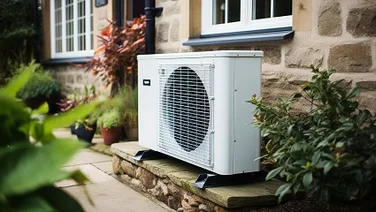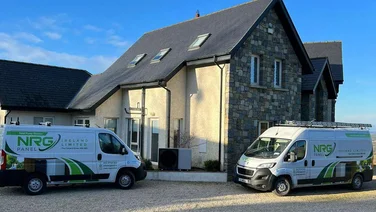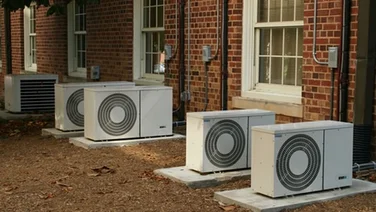- Depending on the type and size of system, air-to-air heat pumps cost between £2,400 and £8,800
- They can easily double as air conditioning units in summer
- The Boiler Upgrade Scheme doesn’t cover air-to-air heat pumps
By 2035, all new boiler installations will be phased out in the UK. And, despite the high upfront prices of heat pumps, this green piece of kit is in a prime position to fill the void.
Close to a quarter of a million UK homes are already using heat pumps, and with initiatives like the Boiler Upgrade Scheme shaving thousands off prices, it’s getting easier to afford one. However, this number could be higher as heat pump expert Bean Beanland explained to EE in a recent podcast, “Heat pumps are everywhere. We are just slow, very slow [in the UK] to using them for domestic heat.”
Heat pumps come with a number of advantages, including reducing reliance on fossil fuels like gas, incredibly high efficiency (in excess of 100s of %), and generally low maintenance. Many models can also double as cooling units for the summer months.
We look into air-to-air heat pumps in this guide, covering what they are, how they’re installed, the costs involved, existing grants (like the Boiler Upgrade Scheme), and whether your home is suitable for one.
So, if you want to start receiving heat pump quotes, fill in our simple form here. Just enter a few details, and we’ll put you in touch with our trusted suppliers, who’ll get back to you with bespoke quotes for you to compare.
What type of central heating do you currently use?
Get started
What is an air-to-air heat pump?
Air-to-air heat pumps are basically the same product as an cooling air conditioning unit, except they can generate heat as well.
They’re a common sight in many office buildings in the UK, and there’s growing residential interest in them.
As they also cool your home, air-to-air heat pumps are already widespread across Europe. But climate change is bringing more heatwaves to the UK, so it’s inevitable that their numbers here will increase.
The range in size from single room conditioning units, to larger multi-room systems with much greater heating and cooling capacities. The kind of system (and ultimately cost) will depend on the size of the space (technically the volume of air) of the area(s) that you need them for.
In most cases, they’ll consist of two main components. The first (usually referred to as the outdoor unit) does the lion’s share of the work and is usually cited outside your property.
This is then connected via a system of pipes to the indoor unit(s) installed inside the parts of building that require the air conditioning. These will usually consist of a wall or ceiling mounted unit.
These two main parts work together to heat or cool the air inside your home. You can have different indoor units heating or cooling that specific room at different temperatures depending on your needs.
They are, in other words, incredibly versatile systems.
How does an air-to-air heat pump work?
An air-to-air heat pump works by “pumping” heat from the air outside to the air inside your home. In its heating mode, this means “extracting” heat from outside and “dumping” it inside. The process is reversible and can be used to “dump” the heat inside your home to the outside when cooling a space.
This is done using a process similar to how your fridge keeps its interior cool. The key components are refrigerants and compressors.
When heating a space, “heat” energy is absorbed in the outdoor unit by a cool liquid refrigerant, turning it into cold gas.
A compressor then squeezes the cold gas, making it heat up. As Bean Beanland explained: “Think of it like a bicycle pump. If you put your finger over the end and pump it up, it gets hot. It is that simple!”
The “hot” gas is then cooled in the indoor unit by drawing air from the room into the unit, which heats the air. This condenses the gas refrigerant back into a warm liquid, and the whole process starts again.
This warm air is then blown into the space in question, thereby heating it up. The process can also be reversed to cool the air inside the property.
What they don’t do is heat water, so you can’t use one to power your shower or provide warm running water.
You’ll need to find an alternative way to have hot baths or showers, which can leave you relying on your gas boiler or using an expensive electric immersion heater.

How is an air-to-air heat pump installed?
An air-to-air heat pump consists of an outside unit, internal pipes, and separate ‘blowers’ installed in rooms throughout your home.
The professional tradesperson will first install the outside unit. They’ll typically place it in a strategic location, so the distance of the unit to the internal blowers is as small as possible.
The next main stage will be installation of the system’s pipework. These pipes carry the refrigerant gas, and the entire “run” needs to be tightly sealed to prevent leakage. These pipes will be run from the outdoor unit to the indoors units where required.
This will usually require drilling holes strategically through the outside wall to get the pipes into the house. The pipes will then be run in concealed areas like under floors or voids in walls, or, where not possible, through some form trunking.
They’ll then install internal units (sometimes called “blowers”) in whatever rooms you want them in. The installer will recommend the best locations, based on putting the blowers as close to the pipework as they can.
You can then heat your home using nothing but warm air and electricity.
What type of central heating do you currently use?
Get startedWant to get a better idea of what it’s like to own an air source heat pump? Check out our case study with Louise, from South London.
Louise had a 12-kilowatt air source heat pump installed to reduce her reliance on fossil fuels, and received £5,000 off the upfront cost through the Boiler Upgrade Scheme. Now, Louise can enjoy a warm, even temperature throughout the house, without fluctuations.
Take a look at the full interview with Louise to learn more.
How much does an air-to-air heat pump cost?
Air-to-air heat pumps cost between £2,400 and £8,800, on average, for a three-bedroom household.
That’s a good deal lower than how much an air source heat pump costs, which is usually £10,000 — though the Boiler Upgrade Scheme will knock £7,500 off the price.
Installing air-to-air heat pumps is cheaper too, because you only need to hook the outside unit that extracts the air to the internal blowers that distribute the heat.
Air source heat pumps require new radiators if existing ones aren’t big enough, and new pipework to carry heated water around, making them more expensive to install.
If you’d rather get an estimate for an air source heat pump, check out our heat pump cost calculator.
Is my home suitable for an air-to-air heat pump?
If you have a smaller home (say a two-up, two-down house), it would definitely be worth getting an air-to-air heat pump, as the bigger a property gets, the less efficient they become.
They spread warmth through smaller rooms more quickly and for longer, as heat dissipates faster in larger rooms.
As air-to-air heat pumps don’t heat water, they’re not suitable for a full boiler replacement. If you want to heat your water, you’ll need to keep or install a dedicated boiler, hot water cylinder or, of course, solar water heater.
If you want to avoid a gas boiler, you can get a hot water cylinder powered by an electric immersion heater, or a heat pump hot water heater.
However, the cost of using an electric immersion heater will be slightly higher — and definitely more expensive than heating water with gas.
What are the best alternatives to an air-to-air heat pump?
Bigger homes moving away from boilers typically install an air source heat pump, which uses an air-to-water method to provide warmth.
They’re capable of heating water and are best optimised for heating larger radiators and/or underfloor heating.
Another option is a ground source heat pump, which uses the ambient warmth of the soil in your garden to heat your home.
These durable, long-lasting heat pumps are an excellent low-carbon alternative to traditional boilers, but they’re the most expensive type of heat pump — prices typically start from £24,000 for a horizontal system and £49,000 for a vertical one.
The latter (more technically called geothermal heat pumps) are usually better suited for larger commercial premises and not usually recommended for homes.
Ground source heat pumps qualify for the Boiler Upgrade Scheme just like air source heat pumps, so you can get a grant of £7,500 to help towards the costs.
What are the disadvantages of air-to-air heat pumps?
While air-to-air heat pumps are great, they, like any technology, have their inherent issues. Some of the most common ones include, but are not limited to:-
- They are expensive to install
- They lose efficiency in cold weather (especially sub zero)
- Units can be noisy
- They take up space
- System are not as efficient if your house is big.
Pros and cons of air-to-air heat pumps
- They dont' use fossil fuels to run directly
- They are super efficient
- The are highly versatile
- They provide heating and cooling
- They are easy to install
- Low maintenance
- Expensive to install
- They don’t work in cold weather
- They’re noisy
- They take up space
Are there any government grants for air-to-air heat pumps?
There are currently no government grants for air-to-air heat pumps, because the cost of buying the unit and installing it is low.
There are government grants for air source heat pumps, which are worth investigating. As it can completely replace your boiler and heat your home, an air source heat pump will be better value for money in the long run.
Once the grid is using more renewable energy, the price of electricity will decrease and this will make heat pumps more affordable to run.
Are air-to-air heat pumps popular in the UK?
The fact that air-to-air heat pumps can’t heat water has limited their residential popularity, because most households need to use an alternative water heating system.
This can be costly and reduces the financial benefits of switching to an air-to-air heat pump. They’re much more popular in the commercial sector, as they provide companies with an affordable way to keep their buildings warm.
The key difference between residential and commercial air-to-air heat pumps is size — units in office buildings are far larger and more powerful. They can provide heat to bigger spaces more efficiently, whereas residential units can only ever be so big.
Summary
- Air-to-air heat pumps are a great way to heat (and cool) your home without burning natural gas.
- They are incredibly efficient, but are expensive to install.
- Air-to-air heat pumps are great if you’re looking to heat small individual rooms or homes, but will need a seperate boiler or hot water cylinder for hot water.
- They are very easy to install, and have relatively minimal maintenance.
- If you can afford an air or ground source heat pump, and would like to keep your radiator or underfloor heating sytem, you might be better off choosing that option.
Ready to start receiving heat pump quotes? Fill in our simple form here with a few details and we’ll put you in touch with our trusted suppliers. They’ll get back to you with bespoke heat pump quotes for you to compare.







